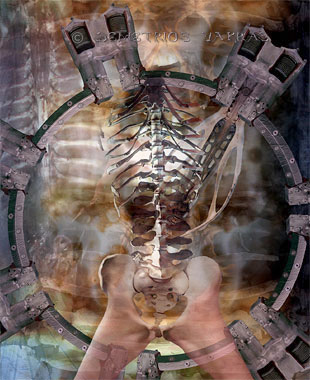|
Two decades ago airbrushing was on the verge of being accepted as a legitimate means for artistic expression. Books published in the late 1970s and 1980s lamented on the hostility of the art establishment accepting airbrushing as a legitimate medium equal to oil-painting, water-colour or etching...... now, it doesn't even rate a mention. Nearly a century and a half ago the advent of photography was to have replaced the artist altogether. That never happened. Photography happily coexists along side oil-painting ... which brings us to computer generated imagery. Although possibly not a transient trend like airbrushing, digital "art" may become its own specialist field, like photography. But practitioners in the field have to understand one fundamental point which has to date been ignored in the discussion: and that is whether the work in question is art regardless of the media used in its creation. ... Take as an example H.R. Giger. His work is airbrushed. Of the plethora of artists whose works were reproduced in various tomes on airbrush art his are some of the few that are still recognised as art. Why? Because his endeavour was to create art, not celebrate the tool it was created with! (There are a few other airbrush artists, Paul Wunderlich for instance, whose art also transcended the celebration of the tool it was created with.) There is a sense of deja-vu about the digital art movement at the moment. It has replaced airbrushing. And, like airbrushing, it has become the tool of graphic designers (who should never be confused with artists). What should never be referred to as art quite often is - and the quite awful is celebrated as the success of the "digital revolution". Much 2D digital work tends to be based on photography and has become the domain of graphic designers. It tends to be a cut and paste of other's photography (collage) - with no credit given to the source of the material. That is, the real artists (photographers) have their works appropriated by a talentless hack graphic designer who imagine themselves to have created art! (In 1929 Max Ernst published his "pictorial novel" La Femme 100 tetes illustrated with his collages of surprising and unexpected juxtapositions. They were works of inspired brilliance. Yet the 2D graphic designer of today who considers their works to be art has usually not even heard of Ernst!) Other 2D digital designers tend simply to launch an application, say, Adobe Photoshop, or Fractal Design Painter, cut, paste, feather edges and apply various filters. With filters a preconceived idea is not needed. A different sequences of filters especially between programs can create different results and thus one source image becomes a plethora of "individual" works of art. This is the pretension to art with the click of a mouse - "art" born not from the desire to express a thought, an idea, but instead created to achieve an aesthetic result... Thus it is decor posturing as art. Alternately there are 3D programs with which to create digital images. With a program like Metacreations Bryce it is extremely quick to create an image. Most of these compositions are generally nothing more than competent flower arranging (although flower arranging may be "an art" it is not art in itself!). You select your objects, group them, select their texture, select the sky, click a button and watch a "painting" materialise. The unfortunate side of Bryce is the ease with which one can arrange objects (which the program can't model) and the assumption made by users that such rearrangments constitute art. The tragedy is when "Brycers" are celebrated for having done nothing more than import a figure (modelled in another program) into Bryce, arranged it within a scene, and then used a scan of a work by H.R.Giger as a texture (that is, the figure will have a Giger painting wrapped around it). The resulting image may look like a Giger, because it actually is. Copyright is an irrelevance to the Napster generation where the appropriation of others' endeavours is considered a right.
Visiting the plethora of 3D web-rings along with what are misleadingly titled "computer arts" magazines, I cringe with embarrassment at what passes for art. Graphic design is peddled as art because the graphic designers tell us it is. If there is a sense of "sameness" it is because constrained by corporate advertising dictates, the design cannot risk alienating the market it is designed for. Banality thus becomes a virtue. (Note: this is much the same as the corporate world's tastes in "Fine Art". Usually a non-figurative work with splashes of colour, smears of paint, without too much skill, is hung on the board-room wall. It adds colour to the walls but doesn't have much, if anything at all, to say .... The art that has proven itself popular to collectors is nonfigurative. It does not affront the senses or sensibilities; works well in decorating corporate walls; is egalitarian, not "elitist", as anyone can do it; can be argued to be "avant-garde" as it rejects "traditional" representational art, and thus appeals to "intellectuals" & theorists... An entire industry of galleries, critics, investment bodies and artists has grown around nonfigurative art. They all have a huge financial and intellectual interest in promoting their point of view. Were it all to collapse the vacuous arguments of the arts intelligentsia would be exposed for what they are & entire collections rendered worthless, not priceless. 24/5/2001) Nudity in art has been derigueur since the Renaissance... However in the digital realm any hint of nudity is to be censored. You won't, for instance, see any of my images which feature the figure - for example the haunting i or hephaesteos' post industrial muse - reproduced in digital art magazines! This censorship might perhaps be pertinent when it comes to advertising or for book/cd cover illustrations, however it has no place in art. At this stage I cannot see digital art being defined as art without being ridiculed. There are some brilliant artists but they are swamped by a teeming mass of mediocrites, illustrators who should never be defined as artists but often are. Ultimately, those digital practitioners who will be deemed artists will be very few indeed - as was the case with airbrushing. (I must, at this point, confess to an admiration for the 3D work created for the film industry: 3D animation. With high-end 3d programs (including the disastrous Lightwave) we have a new art of the imagination animated. However, it must be noted that this industry does nothing more than animate the ideas others have drawn, others have conceived, others imagined, and thus by definition is a craft like that practiced by carpenters, set-builders etc., rather than art. There has yet to be a digital Jan Svankmajer.)
The above image was created in about an hour on 12 January 2002. I did not commence with a preconceived idea. The image was begun in Metacreations Bryce 2 3d, with some tori in a sky and sea-scape. It was then manipulated in Fractal Design Painter 5; then in Adobe Photoshop 5 - using Alien Skin's Eye Candy 3 plug-in; then Corel Photopaint LE 8 where various more filters, including the lense-flares and ripple, were added. It went back and forth between applications until the final result was achieved. Manual in hand I was tinkering to see what could be achieved with Painter 5, installed 2 days prior. Below: crap-another2, 2002, © demetrios vakras and after using some more filters the result is the image below.......:: Below: crap-another2, another, 2002, © demetrios vakras Below: junk jpegged, February 2004, © demetrios vakras Both my painting and 2D work are dependent on my photography... you can't get an engine & carry it into your studio! As an illustration of my methodology, my (2D) digital image Demolisher Suspended is based on photographs taken on the 13/2/2000.. About a block away from where I live was a truck weigh-in station. It was being demolished. I happened to be going past and saw the demolition taking place. So I went home, picked up the camera & walked over. I already had an idea as soon as I saw it! Amazingly though, some images which are successful as oil paintings, work poorly when I have tried to create a digital version of them referring to the same photographs ... Some of the digital work... would never have been put together as an intended painting because I would not have thought of it as being worthwhile doing so! Doing your own photography means you have observed the details yourself, and not simply relied on someone else having done so. But despite the attractiveness of the speed with which images can be created digitally, I do not see these images as a substitute for painting. I have far more options available to me in painting. But more importantly, it has taken me 25 years of practice to become as good as I am. Digital art is about as easy as it gets! My Photoshop images in my main site were created within a matter of weeks of the installation of Photoshop (23/1/1999). I had never heard of Photoshop prior to that & had never used a computer before. The Bryce images are a similar story. I only purchased & then installed Bryce 3D in March of this year (2000) & have virtually created an entirely new web-site of these digital works! Ultimately, painting remains something to marvel at. It is the understanding that someone has picked up a pencil or brush & faithfully rendered not only what they saw before them but also what they can imagine. It is something that requires years of practice to perfect, and something that most people are incapable of achieving. The problem with digital art is that anyone can do it! Digital art offers a virtually unlimited scope for the articulation of an imagination. The great shame is that the vast majority of digital "artists" are those without an imagination as if the purpose of the medium is to give opportunity to those who never had the talent to be artists in the first place. It is much the same as the claim that viewing art on a computer screen can replace visiting an art museum! There is nothing more breathtaking than looking at painting in an art museum that one has only ever seen reproduced in a book. Reproductions of paintings in books are of a far higher standard than anything a computer screen could show. There seems however to be a predisposition to making vacuous statements within the world of the virtual. Demetrios Vakras 15/10/2000 (re-edited 11/1/2002, 26/7/2002) Post Script Whereas in the real art world 3d art is ACTUAL 3d work, sculpture (and assemblages), the computer generated art world has comandeered the word altering its meaning. In this 'digital realm' of computer generated images 3d art is that which is composed of 3d wireframe representations of objects (see screenshot examples below): |
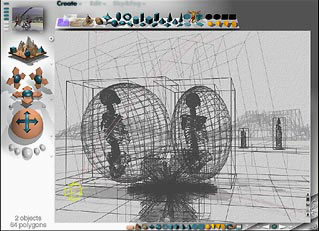 . .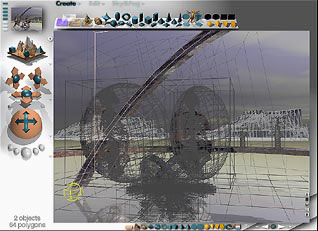 . .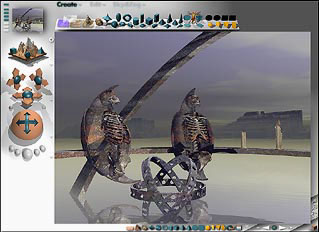 |
|
These images are wireframes of objects which are then given a surface (essentially a skin) and then "rendered", that is the computer actually generates the 'painting'. It should be referred to as virtual 3d....
Addenda 26/7/2003 Today, Saturday 26 July 2003, I stumbled across a computer "art" magazine which in the edition I was looking at, featured an "artist" who extolled the virtue of digital art creation.... I'm not sure what purpose the images served other than to emphasise the shear ease with which anyone can create aesthetically pleasing images on the computer... In the manner of this "artist" I created the following image:
...very pretty, but does creating it, or anything like it, make the creator an artist? ....Since when has design been intergangeable with art? Seduced by the absurdity of the assumption that an instant artist can be made where one did not previously exist, I decided to create a series of "kaleidoscopic" digital images of the kind that confoundingly so enthral some.... simply to demonstrate how easy the process of digital art creation is. First, I created an image in Bryce (created solely by the computer, this image, and the series of images derived from it, are actual digital images):
...no artistic ability required here... Next I took this image into Photoshop, duplicated it, flipped it, and created the following series:
...Very pretty perhaps, but, how much skill does one require to create a simple pattern...? I could have kept going, creating an entire oeuvre in one solitary day ... launched myself an entirely new website & declared myself an artist on the basis of these works... However, since when did the creation of wallpaper become artistic expression? Addenda 27/7/2003 ...And, when it could have been assumed that the potential for additional images from this one source had exhausted itself, I decided that if I combined my first image ( nude with bird wings) with the "kaleidoscopic" image I could then create yet another image...or even a series if I wanted to:
...And if I went just a little further, I could apply the same technique to another image...:
And, as a point of interest, these images themselves were based on an image which was created in the manner of the cut and paste technique with the program Photoshop in which multiple layers are juxtaposed one upon the other at varying levels of transparency:
|
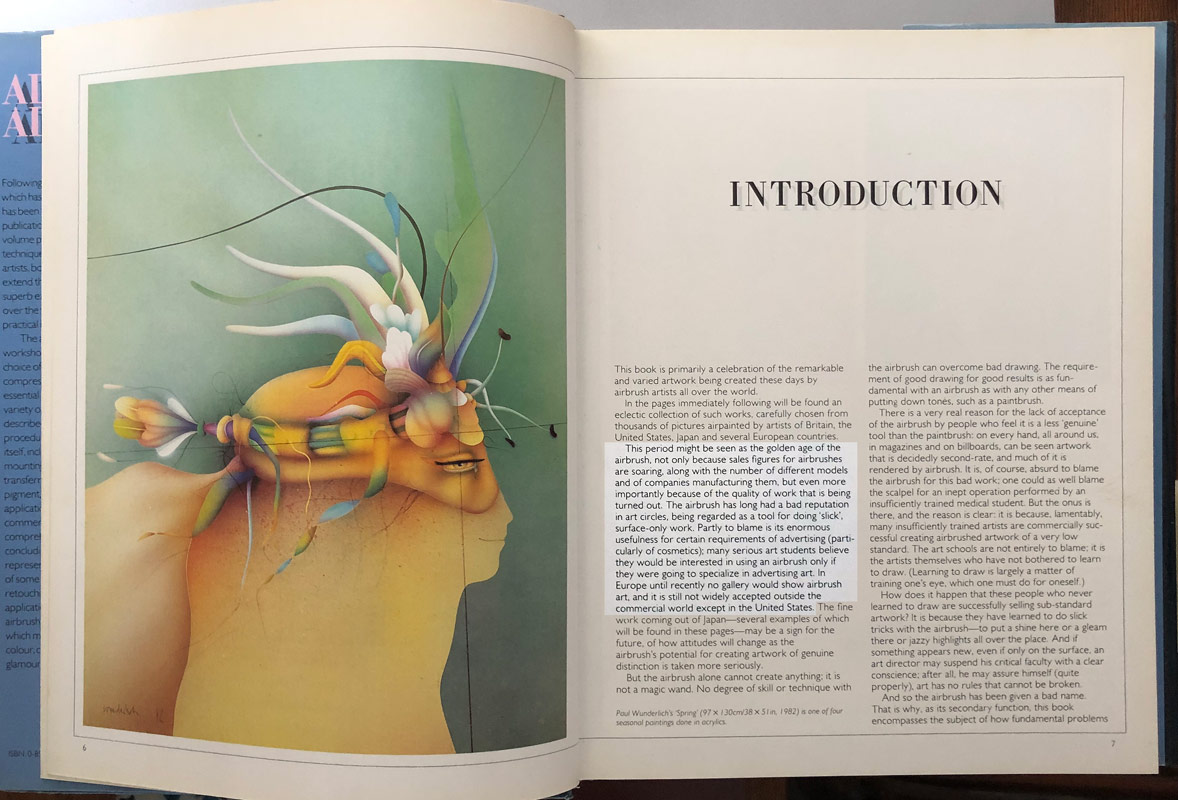
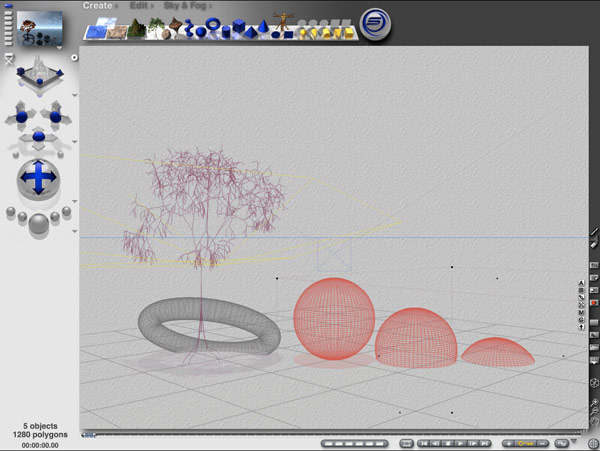
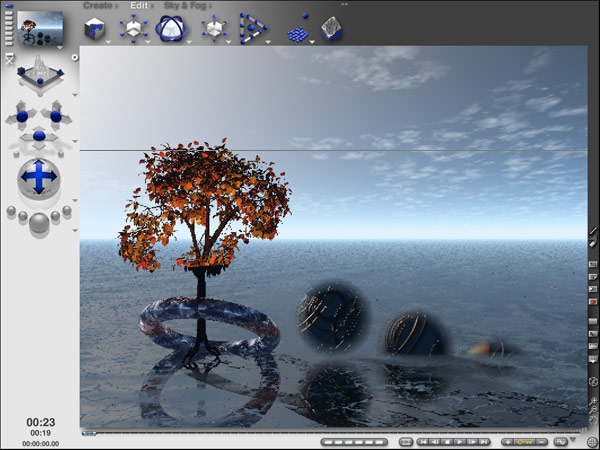
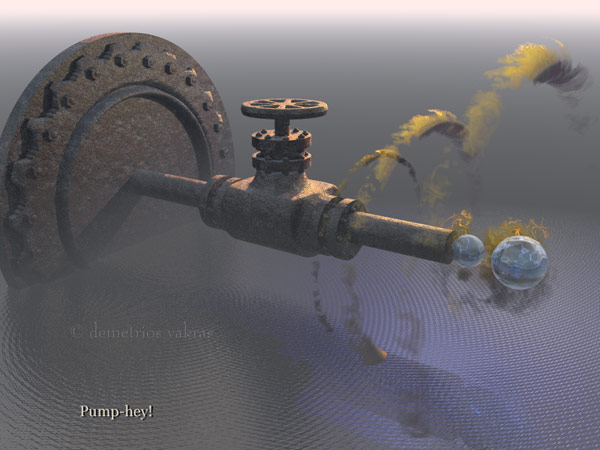
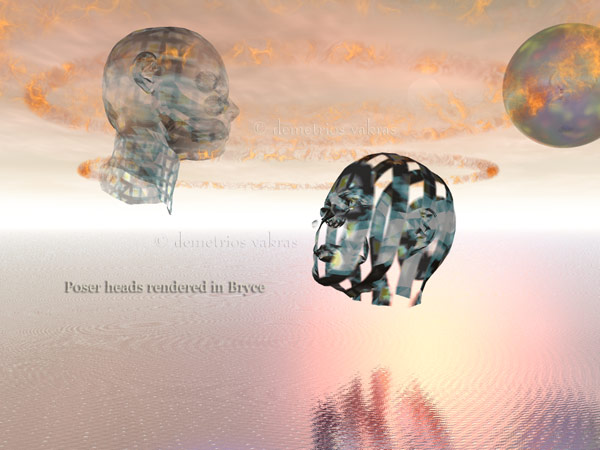
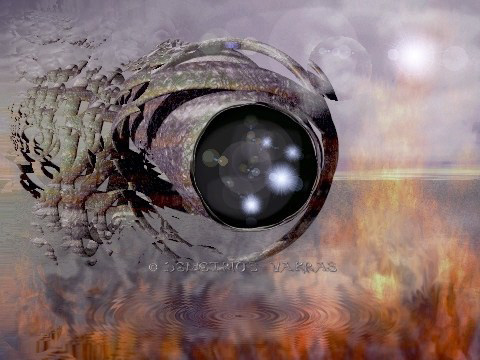
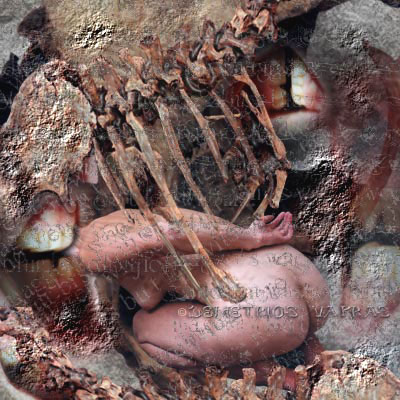
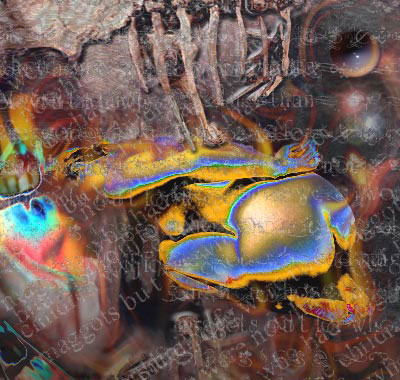
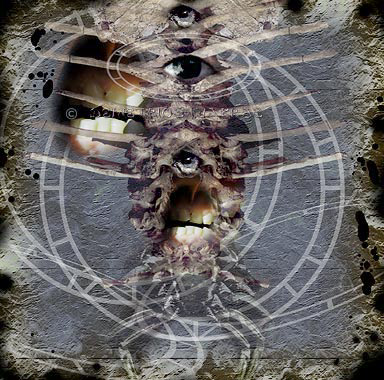
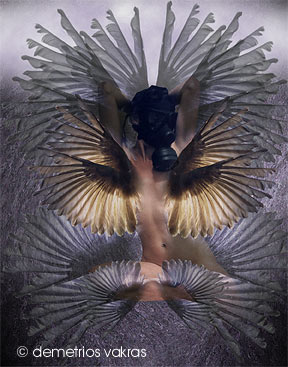
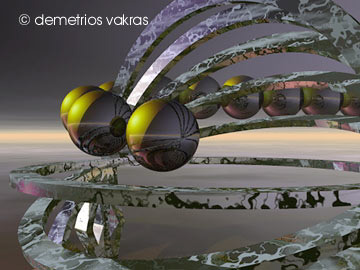
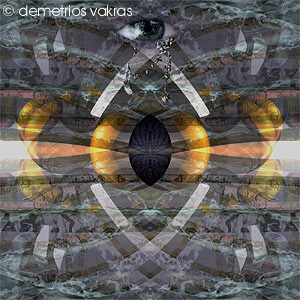
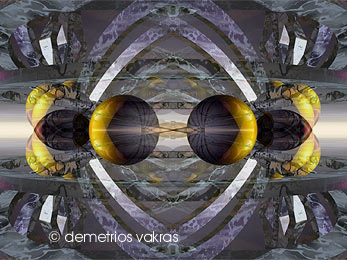
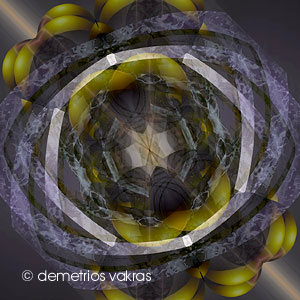
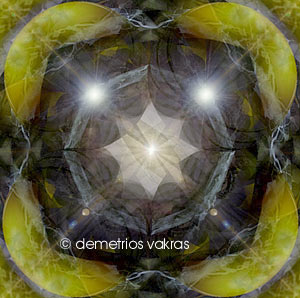
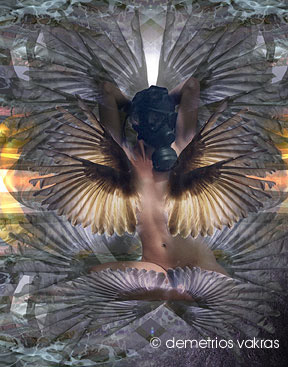
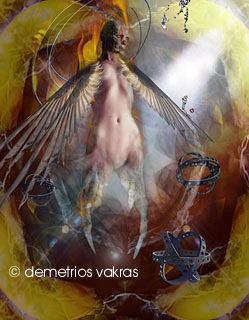
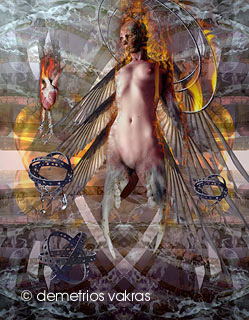
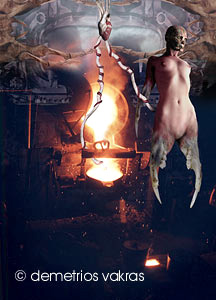
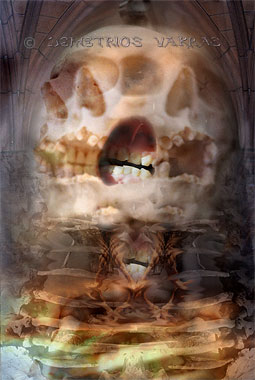
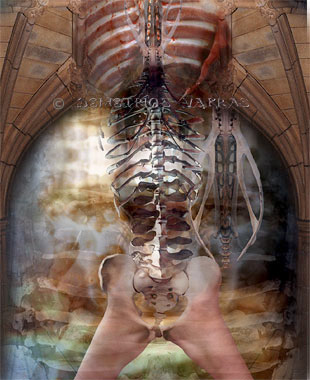 ........
........